Clear Aligners vs Traditional Braces – What’s Better For You?

Published Date: April 12, 2024 Last Update: September 27, 2024
Author: Dr. Manpreet S. Walia
Who doesn’t want a perfect smile? And when it comes to the perfect smile, braces, and clear aligners are the two most popular orthodontic treatments in Chandigarh that aim to treat misaligned teeth and give you a perfectly straight smile balanced with practicality, comfort, and aesthetics. The traditional braces are small metal pieces that are also known as brackets attached to the surface of a tooth and are joined together by a metal arch that applies continuous pressure on the brackets to get a perfectly straight smile while the clear aligners are 3D printed splints that are removable and placed on top of the teeth to correct misalignments. But what’s best for your teeth? Here’s what you need to know to make an informed decision.
Read This Article - How Long Does Aligners Take to Work?
Understanding Clear Aligners and Traditional Braces
Clear aligners are custom-made, removable transparent trays that fit perfectly over your teeth. Invisible aligners are designed to apply pressure to the teeth gradually, moving them into the desired position over time. This solution is discreet and you can easily remove aligners for eating, drinking (other than water), and brushing your teeth. Whereas, traditional metal braces consist of metal brackets attached to the front of the teeth and connected by wires which apply pressure in order to move the teeth.
Pros of Clear Aligners:
1. More Comfortable:
Clear aligners are often considered more comfortable than traditional braces as it has no wires or brackets.
2. Removable:
There is no restriction on what you can eat during treatment as clear aligners are easily removable. So, you can eat anything you like without worrying about breaking wires or dislodging brackets.
3. Invisible:
Clear aligners are virtually invisible, and offer a much more aesthetic result as most of the people won’t even know you’re wearing them because of no metal wires and brackets on the teeth.
4. Better Oral Hygiene:
Clear aligners are removable, so you can easily brush and floss your teeth. You do not have to worry about moving around brackets or underwires, which can significantly reduce your risk of developing cavities and gum disease.
Cons of Clear Aligners:
1. Speech Impediments:
Initially, some patients may experience speech difficulties until they adjust to wearing the aligners and their tongue adapts to the new positioning.
2. Expensive:
Clear aligner treatment can be more expensive than traditional metal braces, depending on the severity of the orthodontic issues and the duration of treatment needed.
3. Maintenance:
Clear aligners require regular cleaning to prevent bacterial buildup and maintain transparency, which may be more problematic as compared to traditional braces.
Pros of Traditional Braces:
1. Effectiveness:
Traditional braces can be more effective for complex issues or significant misalignments. If you need to fix the midline of your teeth or large gaps, traditional braces may be best.
2. Less Expensive:
Traditional braces can be less expensive than other orthodontic treatments.
3. Fast Treatment:
You can’t remove traditional braces yourself. You’ll have to wear them during your entire treatment, and only the orthodontist can remove them after treatment which will straighten your teeth fast. The braces are occasionally tightened to move the teeth.
Read This Article - Effective Ways To Clean Your Clear Aligners At Home
Cons of Traditional Braces:
1. Visibility:
Traditional braces are noticeable, which can cause self-consciousness and affect the wearer’s confidence, particularly in social and professional settings.
2. Discomfort:
Metal brackets and wires can cause irritation and soreness, especially during the initial adjustment period and after tightening appointments.
3. Oral Hygiene Challenges:
It can be more challenging to maintain proper oral hygiene with traditional braces due to the presence of wires and brackets which increases the risk of plaque buildup, tooth decay, and gum disease.
4. Dietary Restrictions:
Certain foods like popcorn, sticky candies, and hard nuts must be avoided to prevent damage to the braces, limiting dietary choices and potentially causing frustration.
What’s Better for You?
The comparison between the two methods can be tough since each has its benefits. However, if aesthetics and comfort are your primary concerns and you require a less complex adjustment, then clear aligners might be the better choice. They’re discreet, convenient for your lifestyle, and just as capable of providing you with a beautiful smile. When you wear traditional braces, you’re restricted from brushing and flossing effectively. One of the biggest advantages with clear aligners is there are no metal brackets or wires involved, so people can brush and floss normally with no extra effort. This can protect teeth from cavities during treatment and reduce the risk of gum disease as well. However, if your orthodontic needs are complicated or if cost is a significant factor in your decision-making process, traditional braces might still be the way to go. It’s important to consult with our orthodontist to determine which treatment is suitable based on specific dental needs.
Conclusion
Both methods are effective in achieving straighter teeth and improving oral health. If clear aligners suit your lifestyle and orthodontic requirements, they can be an excellent choice for unobtrusive teeth correction. So, are you ready to take the first step towards a confident smile while maintaining an almost invisible treatment process? Talk to us! Schedule a consultation today to see if clear aligner braces are the right fit for you.
Relevant Article:- Transform Your Smile to Boost Your Confidence Through Clear Aligners

Leave A Reply